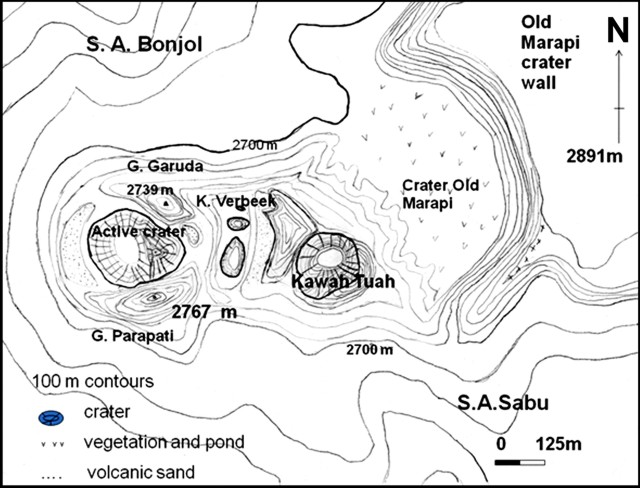Report on Marapi (Indonesia) — July 2011
Bulletin of the Global Volcanism Network, vol. 36, no. 7 (July 2011)
Managing Editor: Richard Wunderman.
Marapi (Indonesia) Increased seismicity in 2004; small ash-bearing eruptions in 2011
Please cite this report as:
Global Volcanism Program, 2011. Report on Marapi (Indonesia) (Wunderman, R., ed.). Bulletin of the Global Volcanism Network, 36:7. Smithsonian Institution. https://doi.org/10.5479/si.GVP.BGVN201107-261140
Marapi
Indonesia
0.38°S, 100.474°E; summit elev. 2885 m
All times are local (unless otherwise noted)
This report first describes a 2005 increase in seismicity at Marapi, then presents a 2010 field map of Marapi's active crater area, and notes several plumes seen in 2011 to 1 km above the vent, some bearing ash. As previously noted, Marapi had generated explosions in 2000 and 2001, and a small ash-bearing eruption in 2004 (BGVN 25:11, 27:01, and 30:01).
Activity during 2005. During the week 8-14 July 2005, the number of earthquakes at Marapi increased dramatically. The seismic network recorded 112 deep volcanic earthquakes, compared to a normal average of 7 per week. Other changes were absent at the volcano, for example, fumarole temperatures were normal and gas emissions typically rose ~ 50 m above the summit. As a result of the increased seismicity, the Center of Volcanology and Geological Hazard Mitigation (CVGHM) raised the Alert Level from 1 to 2 (on a scale of 1-4).
Activity during 2010. During a 4-day visit to Marapi in July 2010, volcanologist Mary-Ann del Marmol created a sketch map of the area (figure 3). More detailed mapping and rock observations of the old crater side of the volcano were thwarted by dense vegetation there.
Activity during 2011. According to CVGHM, seismicity increased during 21 June-3 August 2011. Observers noted that during June, July, and the first day of August white plumes rose 15-75 m above the summit craters. On 3 August dense gray plumes rose 300-1,000 m above the crater on eight occasions. That same day CVGHM raised the Alert Level again to 2. Visitors and residents were prohibited from going within a 3 km radius of the summit.
According to a news article, two eruptions from Marapi occurred on 9 August 2011.
Geological Summary. Gunung Marapi, not to be confused with the better-known Merapi volcano on Java, is Sumatra's most active volcano. This massive complex stratovolcano rises 2,000 m above the Bukittinggi Plain in the Padang Highlands. A broad summit contains multiple partially overlapping summit craters constructed within the small 1.4-km-wide Bancah caldera. The summit craters are located along an ENE-WSW line, with volcanism migrating to the west. More than 50 eruptions, typically consisting of small-to-moderate explosive activity, have been recorded since the end of the 18th century; no lava flows outside the summit craters have been reported in historical time.
Information Contacts: Center of Volcanology and Geological Hazard Mitigation (CVGHM), Jalan Diponegoro 57, Bandung 40122, Indonesia (URL: http://vsi.esdm.go.id/); Mary-Ann del Marmol, Geology and Soil Science Department, University of Ghent, Krijgslaan, 281 S8/A.326, B-9000 Gent, Belgium (URL: http://www.volcanology.ugent.be/delmarmol.htm); Metro TV News (URL: http://www.metrotvnews.com/).


